
Fast, affordable Internet access for all.

An in-depth examination of a particular network
*This is the first installment of an occasional profile on Local Community Broadband Champions where we focus not so much on the technology, construction, and financing of a community network build, but on the personalities of the people who make it happen.
When Devin Weaver isn’t vibing at the Otto Bar or checking out the underground music scene at Metro Gallery, or even playing his bass guitar at home, the 28-year-old network engineer enjoys spending time amid the web of wires in storage closets inside low- and mixed-income apartment buildings dotting the city’s landscape.
It’s where his network design handiwork all comes together, snaking through the buildings to the routers installed in individual apartment dwellings, enabling residents to get gig speed Internet service.
That’s on par with what the regional monopoly provider Comcast offers city residents who can afford it. But in the buildings that Devin has made his technical playground, hundreds of financially-strapped households who subscribe to the fledgling community network he oversees get it for free – thanks to the philanthropy of dozens of organizations including the Internet Society Foundation, the France-Merrick Foundation, and the Digital Harbor Foundation.
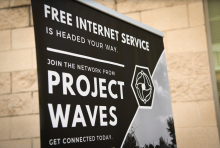
Born and raised in Baltimore, Devin works for Project Waves, a non-profit organization founded in 2018 by an old high school classmate of his, Adam Bouhmad, to bring broadband to mostly low-income households in Baltimore City.
A Small, Rising Wave of Connectivity
Last year, nearly two dozen community leaders in Baltimore were brought together with national experts for a five-week crash course on network engineering, federal policymaking, community broadband networking, and grassroots organizing.
It was an online program called “The Digital Equity Leadership Lab (DELL)” – an initiative created by the Robert W. Deutsch Foundation in response to “other digital inclusion programs across the U.S. that have failed to consider the technical aspects of the Internet and social inequalities alongside broader Internet policy and advocacy goals.”
It spawned a case study led by Colin Rhinesmith, Faculty Associate and Director of the Community Informatics Lab at the UCLA Center for Critical Internet Inquiry and a Senior Fellow with the Benton Institute for Broadband & Society. Released earlier this week, The Digital Equity Leadership Lab (DELL): A Case Study of Community Leadership Development to Promote Digital Equity and Justice highlights the importance of developing community-based leaders around digital equity, gifting rising and next-generation digital equity advocates with important insights for their work.
Through interviews with 15 of the 25 DELL participants, and with the input from a range of national experts and Deutsch Foundation staff, the study set out to answer the question: how might DELL serve as a community-based leadership training model to develop the next wave of digital equity leaders?
The analysis surfaced three key findings:
But the study didn’t stop there. Rhinesmith (with research assistance from Jie Jiang and Malana Krongelb) offers three recommendations in light of the study’s findings:
With the pandemic-induced rise in remote work, distance learning, e-commerce, and telehealth, a new report published by the Urban Land Institute (ULI), sheds light on how the demand for high-speed Internet connectivity has “helped shift the real estate industry itself from thinking just in terms of physical space to also considering how to engage within a virtual environment.”
The ULI report, Broadband and Real Estate: Understanding the Opportunity, identifies the challenges and opportunities in addressing the digital divide and how real estate professionals and land-use planners can play a central role in designing and deploying broadband networks to meet the growing connectivity needs of communities everywhere.
The report explores four instances when community planners placed technology at the forefront of their development projects and details the positive impact it had on the projects -- from a neighborhood in Washington that designed its fiber-to-the-home network with an emphasis on sustainable development and energy efficiency, to a business and tech hub in Northern Virginia, whose owner purchased seven blocks of CBRS spectrum in 2020 to accelerate the deployment of 5G in the area, establishing it as a center for innovation.
Broadband and Real Estate [pdf] also provides guidance on how real estate planners and professionals can be pivotal in creating more equitable and competitive Internet access ecosystems. For example, the report recommends owners of multifamily properties, or MDUs, install carrier neutral wiring sets to each unit, so MDU residents always have a choice among broadband service providers. The report states owners of MDUs should own all of the Internet infrastructure in their building themselves, so it is independent and the property can not be monopolized by a single Internet Service Provider (ISP).
Some key takeaways from ULI’s Broadband and Real Estate report are:
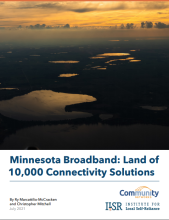
In a new report, the Institute for Local Self-Reliance showcases the diverse range of approaches communities and local Internet Service Providers (ISPs) have taken to expand affordable, high-quality Internet access in Minnesota. It includes a series of case studies that detail how communities are meeting the connectivity challenges of a broken marketplace shaped by large monopoly service providers.
Download Minnesota Broadband: Land of 10,000 Connectivity Solutions [pdf] here.
The profiled projects include municipal networks, public-private partnerships, cooperatives, and private investment. They run from the most rural areas of the state to Minneapolis. Some examples include:
Ry Marcattilio-McCracken, co-author of the report and Senior Researcher with ILSR’s Community Broadband Networks initiative, said of the report’s findings:
Our new report, Minnesota Broadband: Land of 10,000 Connectivity Solutions [pdf], showcases the diverse range of approaches communities and local Internet Service Providers (ISPs) have taken to expand affordable, high-quality Internet access in Minnesota. It includes a series of case studies that detail how communities are meeting the connectivity challenges of a broken marketplace shaped by large monopoly service providers.
The profiled projects include municipal networks, public-private partnerships, cooperatives, and private investment. They run from the most rural areas of the state to Minneapolis. Some examples include:
Ry Marcattilio-McCracken, co-author of the report and Senior Researcher with ILSR’s Community Broadband Networks initiative, said of the report’s findings:
Minnesota communities and local ISPs have found creative and sustainable ways to build future-proof networks across the state, despite a broken marketplace and state barriers that favor slow-moving, out-of-state monopoly providers clinging to outdated technology. Lawmakers must stand up for the cities and towns that sent them to the legislature, and remove the obstacles that prevent a more competitive market and local broadband solutions.
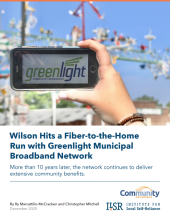
For timely updates, follow Christopher Mitchell or MuniNetworks on Twitter and sign up to get the Community Broadband weekly update.
Built in 2008 with an eye toward the future and operated with local priorities in mind, Greenlight has a long track record of putting people first. In a new case study, the Institute for Local Self-Reliance explores the wide-ranging community benefits of Greenlight, the city-owned Fiber-to-the-Home network in Wilson, North Carolina.
Download Wilson Hits a Fiber-to-the-Home Run with Greenlight Municipal Broadband Network.
The case study details how it has been able to quickly adapt and expand service during the pandemic, as well as the host of advantages and overall value brought to the city over the last decade in education, equity, and economic development. For example:
Access for All
Economic Development
Education
In a new case study, the Institute for Local Self-Reliance explores the wide-ranging community benefits of Greenlight, the city-owned Fiber-to-the-Home network in Wilson, North Carolina. The case study details how it has been able to quickly adapt and expand service during the pandemic.
Built in 2008 with an eye toward the future and operated with local priorities in mind, Greenlight has a long track record of putting people first. A few examples are:
Access for All
Economic Development
Education
A new report out by North Carolina's Broadband and Infrastructure Office looks at the ways that broadband and telehealth can solve some of the disparities that disproportionately affect tens of thousands of its citizens living in the western fifth of the state. These “coal-impacted communities,” it argues, would benefit greatly across a host of interventions which would be facilitated by investment in wireline broadband infrastructure, technical assistance, and digital literacy programs. If implemented, they would increase access to medical doctors and mental health professionals for all North Carolinians, eliminate barriers related to transportation, reduce state healthcare costs, increase the speed of intervention and reduce the time to diagnosis, and eliminate unnecessary hospital and emergency room admissions.
Healthcare in the High Country
"Carolina Crosscut: Broadband and Telehealth in North Carolina's Appalchain Coal-Impacted Communities" [pdf] comes out of a $100,000 Appalachian Regional Commission grant given to the Office of Broadband Infrastructure and the Office of Rural Development for two purposes: to figure out broadband availability and adoption as they relate to health disparities across the twenty-county region clustered along the state’s western border, and to map assets and come up with specific policy recommendations for state agencies and lawmakers.
These are North Carolina’s “coal-impacted” communities, which the report defines as those which exhibit a “generational dependence on coal extraction and related supply chains [which] has resulted in personal and community economic devastation.” To be clear and despite its title, the framing here is economic, and not based on the adverse health effects of working in coal extraction. It should also be noted that the economic impact described in the report surely extended beyond the twenty counties at the center of the study.
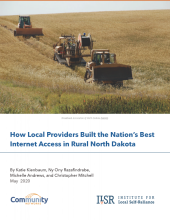
Contrary to the common narrative of poor connectivity and dim prospects for rural America, the vast majority of rural North Dakotans have gigabit fiber Internet access available to them today.
Our case study, How Local Providers Built the Nation’s Best Internet Access in Rural North Dakota, explains how this came to be, highlighting how 15 telephone cooperatives and local companies came together to invest in their rural communities and build fiber broadband networks across the state. In the 1990s, those companies united to purchase 68 rural telephone exchanges in North Dakota from regional provider US West (now CenturyLink). Then, they leveraged federal broadband funds to deploy some of the most extensive fiber networks in the country, turning North Dakota into the rural broadband oasis that it is today.
Download the case study, How Local Providers Built the Nation’s Best Internet Access in Rural North Dakota [pdf].
A Model for Better Rural Connectivity
The case study explores North Dakota's exceptional rural connectivity through several maps and graphs and offers the following takeaways:
Read How Local Providers Built the Nation’s Best Internet Access in Rural North Dakota [pdf].
A recent case study from the Community Broadband Networks initiative at the Institute for Local Self-Reliance (ILSR) finds that rural North Dakotans are more likely to have access to fiber connectivity and gigabit-speed Internet than those living in urban areas. This may surprise many of us city dwellers, who are often stuck with large monopoly providers and their expensive, unreliable Internet access.
The case study, How Local Providers Built the Nation’s Best Internet Access in Rural North Dakota, highlights the efforts of 15 local companies and telephone cooperatives who came together to invest in rural North Dakota and build gigabit fiber networks across the state. Their success is traced back to the companies' acquisition of 68 rural telephone exchanges from monpoloy provider US West (now CenturyLink) in the 1990s. The local providers then leveraged federal funds to connect rural residents and businesses with some of the most extensive and future-proof fiber networks in the country.
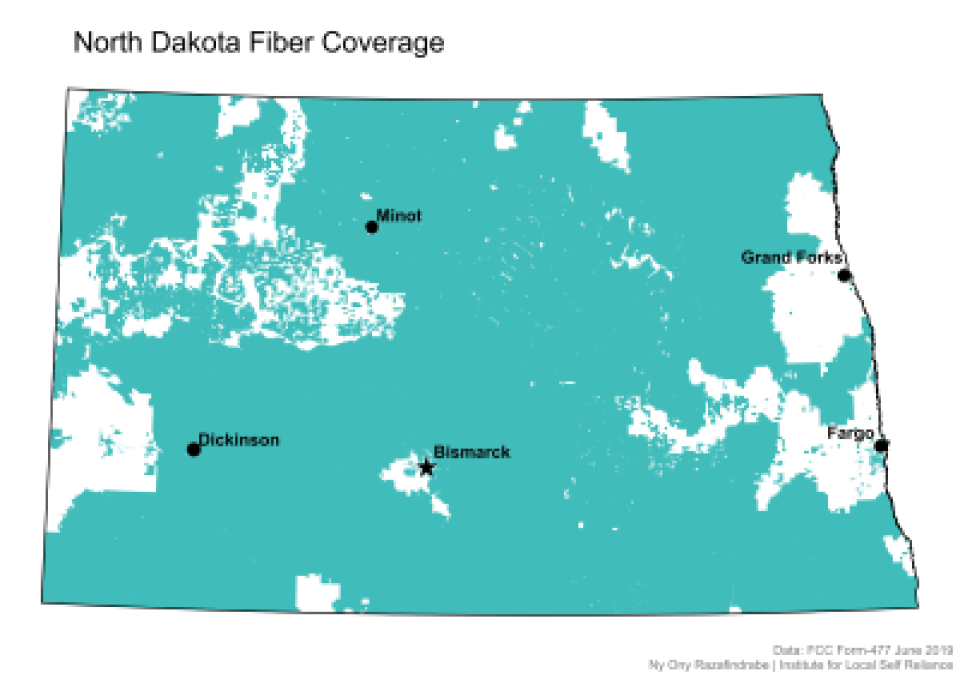
Download the case study, How Local Providers Built the Nation’s Best Internet Access in Rural North Dakota [pdf].
The case study features several maps and graphs that demonstrate North Dakota's widespread, high-quality connectivity, including this map of fiber coverage in the state.
Some key lessons from the case study: